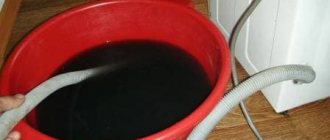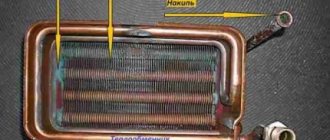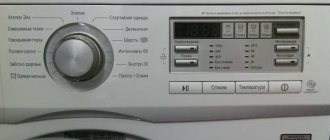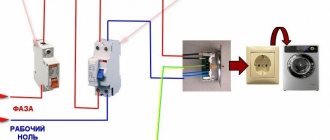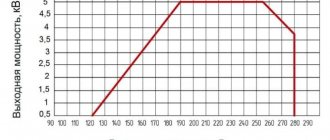How to drain water from a washing machine yourself: 5 ways
There are several ways to drain water from a broken washing machine.
Even a person unfamiliar with the technical structure of the unit can cope with this task. Required:
- washing machine operating instructions,
- a large but low basin/bowl and floor rags,
- physical strength and ingenuity.
Draining your washing machine manually can be time-consuming and labor-intensive. In addition, there is a risk of making a mistake. However, situations are different. It is not always possible to wait for a washing machine repairman to arrive, but the water needs to be drained urgently.
How to independently, quickly and competently drain the water from the washing machine, so as not to harm the equipment and not aggravate the breakdown situation?
How to determine the problem?
It’s almost impossible to immediately say what the problem is with a Samsung washing machine. Finding the cause will take time , since you will have to go through all possible options step by step.
When is water in the tank normal?
In some cases, the problem can be solved very simply. For example, there are types of delicate washes designed to care for wool items that do not end in drainage.
Program crash
Program failure can be caused by changes in voltage, pressure in the water supply , as well as significant overload of the drum with things. The problem associated with power surge is random in nature.
You can try to start the cycle again and see if the drain will run normally.
Drum overload
If there are a lot of things in the washing machine drum, some of them should be removed.
When wet, they become heavy, and the washing machine cannot cope with such a load. After this, you need to turn on the washing machine again and repeat the cycle. If overload was to blame, then it is necessary to draw conclusions and avoid similar situations in the future.
What does the machine itself “say”?
The Samsung washing machine reports a malfunction using error codes sent to the display, as well as sounds uncharacteristic of normal operation.
Eg:
- a malfunction in the control module, pump, pipe, wiring can be indicated in the following combination of letters and numbers - 5C, E2, SE, 5E;
- wiring, poor contact, damaged controller, pressure switch, failure is indicated by codes: IC, 1C, E7, 1E, IE;
- The hum of the machine when it tries to drain may indicate that the pump is airy or that foreign objects have entered the pump.
Features of forced drainage of water from the washing machine
There are 5 ways
Drain the washing machine if it has not completed this washing step on its own.
This is done via:
- Drain hose.
- Drain filter.
- Emergency drain hose.
- Luke.
- Drain pipe.
But:
- not every method will suit a specific model of washing machine,
- it is not always physically possible to do this,
- the danger of a “flood” exists, even if everything is done correctly,
- It is very important to follow safety precautions when handling the washing machine!
When you first discover that the washing machine has stopped the washing process but has not drained the water, the first thing to do is turn it off
!
Important!
With dry hands, remove the plug from the socket! Only then proceed to inspect the car.
Disconnecting an electrical appliance (which is a washing machine) from the network eliminates the risk of electric shock!
Recommendations for housewives and home craftsmen
An impressive list of breakdowns and machine stops without completing the program can be easily prevented by following the simplest operating rules:
- Before loading items into the drum, remove all contents from pockets . Particularly harmful to the unit are coins, paper clips, earrings, rings, small luggage keys and similar metal objects.
- Check the tightness of the buttons and zippers . Before immersing clothes prepared for washing, zippers and buttons must be fastened.
- Use a brush to clean out dust and sand under lapels and in pockets..
- Before washing curtains, remove the hooks that connect them to the wheels of the curtain rod.
Do not forget that a washing unit is a complex technical device that requires careful handling.
It will be useful to put thin linen and items with lint in mesh bags, specially produced for washing in machines. Instead, it is permissible to use thin fabric or a bag sewn from it yourself.
We regularly clean the drain system filter at the intervals specified by the manufacturer.
If we load a lot of worn-out laundry into the drum, clean the filter after each wash.
Reasons why water does not drain in a washing machine
The lack of drainage in the washing machine is a consequence of an unusual situation.
If the washing machine stops draining water:
1.You have selected
non-draining
wash cycle , such as delicate wash or woolen wash.
Solution.
Check if you have a special mode installed. Information about modes that do not involve draining water is contained in the instructions for the washing machine.
2.
The drain hose is pinched.
The drain hose connects the machine to the sewer. It may be twisted or pinched. Water physically cannot go down the drain.
Solution.
Move the drain hose to the proper position and try to start the water drain mode.
3.Clogged
drain filter or sewer.
Solution.
You can remove the blockage yourself or invite a washing machine repairman.
4. Out of order
pressure switch (water level sensor), control board or pump pump. These parts can only be repaired or replaced with new ones by a professional technician.
Solution.
Order a washing machine repair service and try draining the water from the unit yourself before the technician arrives.
Why did the washing machine break down?
For what reasons does the washing machine not spin out the laundry and drain the water?
- The drain hose or its connection to the siphon (sewer) is clogged.
- The drain hose is kinked and is preventing fluid from flowing out.
- Incorrectly set mode. For example, the “Wool” program is carried out without spinning.
- The drain filter is clogged with foreign objects. These can be buttons, decorative elements from clothes.
- The pump impeller is blocked, so it cannot pump out water. At the same time, you can hear the hum of the pump.
- The drain pipe is clogged with debris.
- Incorrect operation of the pressure switch. The sensor sends incorrect readings to the board about how full the tank is.
- Main module failure. The triac responsible for the operation of the pump failed and burned out. The module needs to be repaired or completely replaced.
Such problems may be accompanied by an error code on the display - then it will be easier for you to understand where to look for the problem.
- "Indesit", "Ariston" - F11, .
- Bosch and Siemens - F18, disassemble the case.
- "Electrolux" and Zanussi (Zanussi) - EF1.
- LG - .
- Samsung - .
- Beko - .
- "Whirlpool" - F03.
Before you begin troubleshooting, forcefully drain the system. There are five ways to do this, regardless of the brand of SMA: Candy, Ariston, Gorenje, Ardo and others.
Draining water through a hose or pump filter
These are the two best ways, both quick and easy.
Drain hose
connected to the back wall of the washing machine and put into the sewer. It is usually corrugated and gray in color.
To drain the water:
- Disconnect the hose from the sewer.
- Place it in a pre-prepared large bowl/basin and hold it there. Water will begin to flow out.
Drain pump filter
located at the bottom of the front panel of the washing machine under a decorative hatch or panel.
To drain the water:
- Open the decorative hatch/panel. You will see a round filter.
- Tilt the car back slightly and lean it against the wall.
- Place a container under the drain filter to collect water.
- Turn the filter handle counterclockwise, but do not unscrew it! The water will flow.
A washing machine is a bulky unit. Be careful and careful when handling it to avoid household injuries!
How to clean the drain filter
After draining the water, unscrew the debris filter by turning it counterclockwise. Residual water may leak out, so cover with a cloth.
Rinse the filter with an old toothbrush under running water.
Shine a flashlight into the hole from which the filter was removed. Locate the drain pump impeller (orange part in the photo) and remove debris from it, usually hair or thread. It is convenient to use tweezers or small scissors for this. To ensure proper operation of the drain pump, rotate the impeller 1-2 times in each direction.
Screw the drain filter into place tightly by turning it clockwise.
Drain directly through the hatch
Opening the machine and scooping water out of it manually is perhaps the first thing that comes to mind when such a problem arises. This is not the best way, but acceptable if the first two did not work.
Note! Not every model of washing machine will unlock the hatch after being turned off. If the door does not open, this option is not suitable for you.
If the water level in the tank of the machine is higher than the hatch, when it is opened, it will rush out in a stream. To avoid this, tilt the unit body back towards the wall, and then open it.
Reasons why the drain does not work
Samsung automatic machines allow you to perform a full washing cycle without human intervention, strictly following the program set at the beginning. First, the washing is done, and only after that - rinsing and spinning. If the drain does not occur, the cycle stops.
The main reasons why the drain does not occur:
kinked or clogged hose;- breakdown of the pressure switch;
- filter clogged;
- pump wear or air trapped in it;
- foreign objects entering the pump, concentrator;
- pipe blockage;
- sewer blockage;
- damage to electrical communications in the device itself;
- control module failure.
To determine the cause of the drainage problem, it is necessary to carry out diagnostics.
Draining through the drain pipe
This is the most time-consuming and undesirable option for forcibly draining water from the washing machine.
To drain the water:
- Detach the back panel of the washing machine.
- Locate the drain pipe under the drum. It connects to the pump.
- Place a bowl under the pipe and place rags nearby.
- Remove the clamp from the pipe and disconnect it from the pump. The water will flow in a stream. If not, there is a blockage in the pipe.
Certified and experienced technician
VseRemont24 service center will cope with the task of draining water from the washing machine quickly and efficiently. You can safely entrust this task to him, as well as all subsequent repairs necessary to the washing machine.
Call a technician to your home if your machine stops draining water! After a couple of hours of work by the technician, it will work properly again!
Fluid Removal Options
It is safest to empty the washing machine in automatic mode - through the provided one. Everything is simple here: scroll the selector to the appropriate position and start the cycle. However, if the system freezes, this option does not work. If the “tidy” does not respond to the user’s commands, you will have to forcefully drain the water manually. “Manual” draining is started in the following ways:
- through the drainage sleeve, by gravity;
- unscrewing the garbage filter;
- emergency “opening” of the hatch;
- by uncoupling the pipe connecting the tank and the volute.
Before forced draining, equipment should be disconnected from communications: power supply and water supply.
Each of the forced options has its own risks and benefits. Much depends on the situation - sometimes only “opening” the drum is possible. In any case, you first need to turn off the power to the machine, turn off the water and assess the scale of the situation, and then choose the appropriate drainage method.
Unscrew the plug of the garbage filter
Any Indesit washing machine is equipped with a special filter that prevents foreign objects from entering the pump - coins, paper, paper clips. It is very easy to access the filter element - it is located on the front of the machine, in the lower right corner behind the false panel. Algorithm of actions when draining water through a garbage filter:
- Using a slotted screwdriver, release the latches and remove the decorative panel;
- tilt the washer slightly on its left side, carefully lean the body against the wall and place a basin under the bottom to collect the liquid. Make sure that the machine does not slip;
- cover the floor around the SMA with rags that absorb water well;
- Unscrew the filter a few turns until water flows out from under the plug. There is no need to completely remove the filter element from the system;
- collect the liquid in a container.
Unfortunately, it will be very difficult to ensure a “clean” drainage of water in this case; some of the liquid will still spill. The floor will have to be wiped by hand. But there is also a significant advantage of this method - the whole process will take very little time, since you do not have to disassemble the washing machine.
Possible causes of failure
The reasons for not removing the cleaning solution from the working space of the washing machine are similar for all brands and models of devices. They do not depend on the type of loading of the washing machine, its technical complexity or power. In the general description, the washing cycle is interrupted without ending with the proper removal of liquid into the drain. Sometimes there is additionally a lack of spin.
The reasons why the washing machine cannot completely drain all the water are divided into the following groups:
- Clogged internal channels or units. This case occurs very often. Fibers separating from the fabric, threads from unraveled stitches, small debris from pockets and other foreign objects get into the internal nodes and cause breakage.
- Drain hose clogged. Then the debris blocks the drain hose or adjacent sections of the sewer and prevents the discharge of the used cleaning solution.
- Technical malfunctions can be represented by minor disruptions in the operation of the system or serious breakdowns of the unit.
Sometimes the reason for the lack of drainage is simple carelessness. If a washing mode is selected that does not involve draining the used solution at the end, to restore functionality it is enough to simply restart the device.
If the technical breakdown is complex, it is not recommended to fix it yourself. In addition, all service centers that service household appliances of a certain brand, after the owners of the device try to solve the problem on their own, refuse to carry out service repairs. But before disassembling the unit, you need to make sure that there are no obstacles to draining the liquid in the hose or in the sewer.
In order for a washing machine to wash, you do not need to heat the water separately - it does it on its own. Liquid…
Call the master
Some problems with draining a Samsung washing machine can be solved on your own, even with minimal knowledge about the functioning of the equipment. But for serious breakdowns you can’t do without a specialist.
The cost of work alone depends on the company’s price list, the type of work performed, the use of additional parts and consumables (for example, sealant).
On average, the price in the capital and large cities is slightly higher than in the regions:
- cleaning the drain filter – from 1,000 rubles;
- pipe cleaning – from 1,200 rubles;
- pump replacement – from 1,500 rubles;
- repair of the control module – from 1,500 rubles;
- replacement of a water level sensor – from 1,300 rubles, etc.
A list of companies that provide warranty service for new washing machines can be found in the documents that are provided when purchasing equipment, as well as on the Internet. For machines whose warranty has expired, you can find a repair company on the World Wide Web.
It is not advisable to contact private individuals, as there is a chance of running into scammers who can lure money for parts and simply disappear.
After completing the repair work, the representative of the household appliance repair company issues a guarantee for the work performed.
Find out more about repairing Samsung washing machines in this section of the site.
Why doesn't the equipment drain the water?
Causes of problems in Ariston:
- Program crash. Perhaps there was a network overvoltage or a power outage, which allowed the Ariston machine to “think” about performing the task at hand, specifically about draining, or to stop working completely. Knocking on the top cover or the presence of heavy objects similarly cause a malfunction, which also stops the drain.
- The drain hose is blocked by foreign objects.
- Clogged sewer system.
- Foreign objects have entered the filter.
- Pump or pump failure.
- Extension of the hose or placement at an unacceptable level.
- Wiring open or shorted.
Some of the problem can be solved yourself, while the machine will remain in working order. The owner of Ariston is lucky if his machine is equipped with the Smart diagnostic function. Using special keys, Wi-Fi and a smartphone, the machine is diagnosed, and after a few seconds a notification is received about the breakdown, the possible cause and how to fix it. This option is factory-installed, but is installed in more modern Ariston models.
What to do if Smart diagnostics is not provided by the manufacturer? Then all that remains is to conduct an independent inspection of the equipment, finding out why the drain is not working. Some Ariston models equipped with an electronic display may display an error code, which will simplify the search, but this function does not work on mechanics.
What to do?
It is recommended that you begin to determine what the cause of the failure is with the simplest and easiest to resolve options . If analysis and diagnostics require even partial disassembly of the washing machine, it must first be disconnected from all communications.
Kink or squeezing of the hose
Careless handling of the drain hose may result in water not draining.
This situation often occurs when moving the washing machine itself or moving the tube passing from the machine to the siphon.
If the hose is pinched or severely bent, it must be straightened . As a result, patency may be restored. To check, select the drain mode and monitor the condition.
The washing machine should not be too far from the sewer connection point. The best option is up to 3.5 meters.
Filter clogged
This part is designed to retain small debris that accidentally gets into the drum. These could be coins, torn buttons and hooks, etc. This filter is almost always located at the bottom right behind a separate panel.
Emergency “opening” of the machine
If for some reason you cannot drain the Ariston Hotpoint through a garbage filter and hose, you will have to turn to the “heavy artillery.” The latter means an emergency opening of the hatch door followed by scooping out water. This procedure will require more effort and time, so we proceed to it as a last resort.
We proceed like this:
- we estimate how much water is in the tank (if the liquid level is above the edge of the drum, then tilt the machine back and fix it);
- open the machine;
- scoop out the water.
A simple sequence is complicated by some nuances. The first is the need to urgently open the door. It will not be possible to open the hatch by pressing the handle, since Ariston is securely blocked during washing. The blocking is bypassed using a rope, which must be inserted into the gap between the door and the body and, directed into the depth, pulled until a characteristic click is heard. Afterwards we unlock the machine in the usual way.
Emergency hose
Most washing machines have a special emergency drain hose hidden behind a small hatch on the front of the unit. To drain water through it, follow these steps:
- Get the hose.
- Remove the plug from the hose and pour water into the container provided. It has a small diameter, so the process takes a long time.
Solutions to the problem
The only resuscitation measure available to you is forced drainage of water. After doing this, your machine will probably spin like new again. We list the options in descending order of preference.
The drain pipe is the key to the problem
The only regular and legal way to remove water from the machine is a hose that extends from somewhere in its depths (in fact, it is connected to the pump) and comes out from the bottom at the back. Everywhere, both on ancient models and on ultra-modern ones, it is mounted so that a loop is formed at half the height. Because no one has yet repealed the law of communicating vessels. We do the following:
- Place the free lower end of the hose in a basin.
- We remove it from the bracket that forms the squiggle and slowly (this is important) lower it to the floor.
- As it descends, the water levels become equal and it begins to flow from the hose. Even if grandpa’s woolen sock gets into the impeller, it will flow out, even drop by drop.
- Once you have filled the basin completely, return the loop to the bracket. Empty the container and repeat the operation until the machine tank is completely drained.
Drain through the hatch
Produced when you cannot reach the standard hose. In modern washing machines, the maximum water level reaches the edge of the loading hatch or is 2-3 cm above it. Therefore, you can safely open the door by laying a rag.
If you don’t want to spill at all, tilt the washer backwards, placing something under the front legs. After de-energizing, the lock will unlock after 5 minutes (or so). You will need:
- Rubber hose with an internal diameter of 3-5 mm.
- Medium sized syringe.
- Basin.
They opened the hatch and inserted a hose between the cuff and the drum. You can act like a real driver, but water with washing powder is not nectar. Squeeze the syringe, insert it tightly into the hose and release it, then pull it out sharply, holding the end over the basin. The water should run.
Filter and emergency hose
On the front panel, at the bottom, there is a hatch. There is a plug underneath, along with which the filter is removed. The method is good for those who have nerves of iron. The plug must be opened very smoothly so that the water just begins to ooze out. Unfortunately for you, the location of the filter is such that it is impossible to avoid a local flood.
Some manufacturers place an emergency hose next to the filter. This “pip” is very thin and often short. Using it to drain water is quite a task. The danger of a spill remains.
